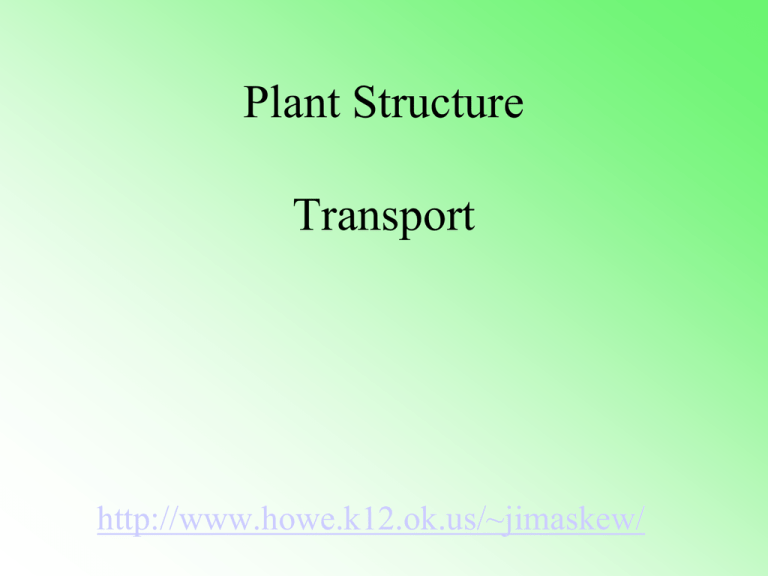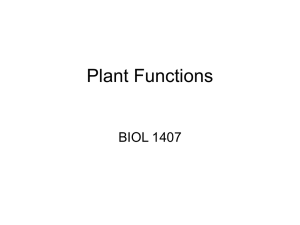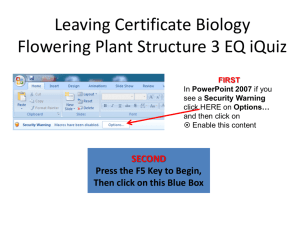Plant Transport PPT
advertisement

Plant Structure Transport http://www.howe.k12.ok.us/~jimaskew/ 3) Vascular Tissues - transport water and food through the plant. a. Phloem: straw-like tubes conducting food downward in a plant. b. Xylem: straw-like tubes conducting water and minerals upward in a plant. A. Roots 1) Function - Roots support and anchor the plant (Similar to Rhizoids) - Roots absorb water and minerals from the soil - Roots store glucose (starch) – Root cell growth pattern: Division, elongation, and differentiation Roots anchor plants and absorb mineral nutrients from soil. • Roots provide many functions. – support the plant – absorb, transport, and store nutrients – root hairs help absorption b. Structure: Roots are made up of many tissues • Dermal Tissue-covers the outside of a plant. – protects the plant –the root cap – Absorbs water from the soil-the root hairs • Ground Tissue-found inside-provides support -stores materials in roots • Vascular Tissue-contains xylem and phloem – Xylem transports water – -Phloem transports food and minerals Types of roots - Taproot - Fibrous - Aboveground(epiphytes) Fibrous root systems have fine branches. They are usually extensive and shallow. Taproot systems have one main root. Fibrous root Ex. Grasses Taproot Ex.carrots Epiphytes Plants that are not rooted in soil but instead grow directly on the bodies of other plants. Most are found in tropical rainforest biomes and they are NOT parasitic. Spanish Moss Orchid B. Stems 1) Function - stems support the plant - stems hold the leaves toward the sunlight - inside the stem water and nutrients travel to other plant parts - stems of some plants store glucose in the form of starch Types of Tissues in Stems • • • • Dermal Tissue- Outer bark of woody stems Ground Tissue Vascular tissue- xylem and phloem Meristematic Tissue-contain both apical and lateral meristematic tissue for growth Annual Rings . The width of tree rings help determine the amount and conditions of growth. 1/30/07 L Tree rings help determine the age of a tree 13 C. Leaf 1) Function - leaves capture light from the sun - leaves make glucose through photosynthesis - leaves take-in CO2 release oxygen O2 2) Structure - top layer is made of a waxy cuticle (prevents H2O loss) and epidermis(dermal layer) -middle layer is the mesophyll (ground tissue) contains most of the chloroplasts -bottom layer exchanges gases through the stomata Stomata Stomata visual concept: Guard cells Image of a Stomata Guard Cells Plant Adaptations Aquatic plants To take in sufficient oxygen, aquatic plants, have tissues with large air-filled spaces through which oxygen can diffuse. Stomata located on top of leaf! Desert plants Have extensive roots, reduced leaves, and thick stems that can store water. Leaves are modified to reduce evaporative water loss and, often, to deter herbivores. Transport in Plants • KEY CONCEPT The vascular system allows for the transport of water, minerals, and sugars. Water and dissolved minerals move through xylem. UVWX Up / vascular tissue/water travels / in xylem Water travels from roots to the top of trees. 3 main ways Transport of Water • animation of water transport • -1- Absorption • -2- Capillary action(cohesion-tension theory) • -3- Transpiration Capillary Action The cohesion-tension theory explains water movement – Plants passively transport water through the xylem. – Cohesion is the tendency of water molecules to bond with each other. – Adhesion is the tendency of water molecules to bond with other substances. Transpiration is the loss of water vapor through leaves. – water vapor exits leaf stomata – helps pull water to the top branches – Factors that affect transpiration: – Temperature – -Wind – -Humidity Phloem carries sugars from photosynthesis throughout the plant. • Phloem contains specialized cells. – sieve tube elements have holes at ends – companion cells help sieve tube elements – unlike xylem, phloem tissue is alive • PH-F-Food The Pressure-flow model explains sugar movement 2 phloem xylem sugars 1.Sugars move from their source, such as photosynthesizing leaves, into the phloem. water 2.Water moves from the xylem into the phloem by osmosis, due to the higher concentration of the sugars in the phloem. The water flow helps move sugars through the phloem 3. The sugars move into the sink, such as root or fruit, where the are stored.





